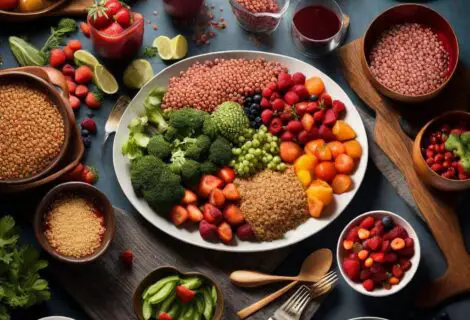Mastering Plant-Based Meal Planning
Introduction
Embarking on a plant-based journey? Our brief guide simplifies plant-based meal planning, ensuring balanced, delicious meals that support your health and sustainability goals. We dive into nutrition basics and offer practical meal prep strategies. Whether you’re a vegan veteran or a curious newcomer, let’s journey together into the nutrient-rich world of plant-based cuisine.
The ABCs of Plant-Based Eating
Making a dietary shift to plant-based eating can be an exciting adventure in discovering new flavors and nutrients. There are numerous paths to achieve a plant-based diet, each as unique as a snowflake. The cornerstone of a successful plant-based journey is understanding the balance of macronutrients – carbohydrates, protein, and fat. Sourced from fruits, vegetables, grains, nuts, seeds, and legumes, these provide the fuel your body needs to thrive.
Plant-Based Protein
An often-heard question is: Where will you get your protein? Legumes, whole grains, nuts, seeds, and even some vegetables can offer substantial protein content. A varied diet will ensure you meet your protein needs.
Essential Fats
Omega-3 fatty acids, crucial for brain health, can be found in flaxseeds, chia seeds, hemp seeds, and walnuts. These can easily be added to meals to boost your intake.
Fiber-rich Carbohydrates
Whole grains, fruits, vegetables, and legumes are not only high in fiber but also packed with essential vitamins and minerals.
Plant-Based Diet Tips for Beginners
Planning: The Heart of the Plant-Based Journey
Understand Your Nutritional Needs
Firstly, comprehend your unique nutritional needs which depend on your age, sex, activity level, and health conditions. Knowledge is power, and understanding what your body requires can guide your meal planning.
Make Your Plate a Rainbow
Incorporate a variety of colors and types of fruits and vegetables to ensure you get a wide array of nutrients. Exploring new ingredients and recipes can make your plant-based journey an exciting culinary adventure.
Don’t Forget Hydration
Drinking plenty of water is essential, especially when increasing your fiber intake with a plant-based diet.
The Power of Whole Foods Plant-Based Eating: A Lifestyle Choice
The Building Blocks: Plant-Based Recipes
Breakfast Options
Breakfast can be a smorgasbord of plant-based delights. Consider nutrient-packed smoothies, overnight chia pudding, scrambled tofu, or whole grain pancakes topped with fresh fruit and a drizzle of nut butter.
Lunch and Dinner Delights
There’s a world of possibilities for plant-based lunches and dinners. From grain bowls featuring quinoa, black beans, and colorful veggies to homemade veggie burgers or a comforting bowl of lentil soup, the options are endless.
Don’t Forget the Snacks
Snacks play an essential role in maintaining energy levels throughout the day. Consider snacking on fresh or dried fruit, veggie sticks with hummus, or a handful of mixed nuts and seeds.
The Practicalities: Making Meal Prep Work
The Power of Planning
Planning your meals not only streamlines your grocery shopping but also ensures you have a balanced, varied diet.
Cooking in Batches
Batch cooking and freezing individual portions can be a game-changer for maintaining a plant-based diet, especially during busy weeks.
Investing in Essentials
Kitchen gadgets like a blender, slow cooker, and a collection of food storage containers can significantly simplify your meal preparation process.
A Sample Plant-Based Meal Plan
Day One
- Breakfast: Quinoa porridge with mixed berries and almonds
- Lunch: Chickpea salad with mixed greens, cherry tomatoes, cucumber, and tahini dressing
- Dinner: Lentil curry with brown rice
Top 10 Tips for Creating a Balanced Meal Plan
Conclusion
Remember, the journey to a plant-based diet is a marathon, not a sprint. Flexibility, planning, and variety are key to enjoying this lifestyle change. Don’t stress over the occasional non-plant-based meal, but celebrate your progress and savor the wonderful flavors of plant-based eating. Happy meal planning!
Comment
We’d love to hear your thoughts on this guide to plant-based meal planning. Do you have any tips, recipes, or experiences you’d like to share? Or perhaps some challenges you’ve faced while transitioning to a plant-based diet? Please leave a comment below. Your insights could help others on their journey towards plant-based eating.
If you found this guide helpful, please share it with friends, family, or anyone else you think could benefit from it. The more we share, the more we can grow and learn together in our pursuit of healthful, plant-based living.
Don’t forget to subscribe to our newsletter for more plant-based tips delivered directly to your inbox.
10 Quick Healthy Breakfast Ideas for Busy Mornings
FAQs
Can I get enough protein on a plant-based diet?
Absolutely. Foods like lentils, chickpeas, tofu, tempeh, quinoa, and many more are rich in protein.
Do I need to take supplements?
It can be beneficial to consider a B12 supplement, as this is the only nutrient not readily available from plant foods. Always consult with a healthcare provider before starting any new supplement regimen.








